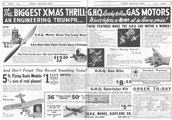Bernie Winston on the GHQ
In the June 1987 issue of "Model Builder", regular engine reviewer, Stu Richmond, took the GHQ as his subject. His review is especially noteworthy for reprinting a portion of a letter from Burnie Winston himself. The relevant section appears below, preceeded by Stu's lead-in to the letter, followed by Burnie's take on the GHQ.
Normally this is as much space as this column gets each month, but I struck gold when research yielded a letter to me directly from Bernie Winston who runs America's Hobby Center, Inc., 146 West 22nd Street in New York City. Bernie Winston's business owned the G.H.Q factory! With his permission, I share parts of his great and interesting letter with you as follows:
"The original engine had been developed from an engine made at that time by a model engineer, Mr. Redfield. Louis Loutrel changed it so that it could be produced commercially. The engines were made in a rented, storefront factory in the area of the Bronx known as 'Fort Apache'. We purchased the manufacturing equipment from Loutrel after he demonstrated his engine under all conditions. We paid him an all cash deal upon his promise to train our men to produce the engine. He worked for us for some time, but he was very unreliable; but, by that time, we had arranged for diecast aluminum parts. The spark coils that he had made by hand were made for us by automatic machinery for far less than any on the market at that time. The diecast parts were far better than any on the market at that time. Most other engines were made with sand-cast parts. We started production about 1935-36 and ended about 1944, since I had been notified of my induction into the Army. We had enough engines on hand to last quite a while. The government had given only two engine manufacturers allotments of critical materials needed for production, including tungsten (for ignition points) and cast iron for other parts. These allotments were based on proof of sales volume that we were able to produce. As far as we know, only Herkimer (O.K.) had sufficient proof as we had. While we produced on a steady basis, we turned to a lightweight, stamped piston (a revolution in engineering) ground to concentricity extremely accurately. We also developed a drop-forged crankshaft that was ground very accurately on the bearing surface.
While some of the tooling still exists in our basement, the dies for casting were destroyed after 15 years of nonuse. One of the differences (humorous or otherwise) was that the G.H.Q. ran and was designed to run the opposite rotation of the engines of today.
"We did fall behind in production at one point when a good many of our employees (a group of motorcyclists who parked their machines in an entry way of the building) were discovered to be filling their empty tool boxes with our equipment. It took quite a while to retrain new employees (about 20) to handle the work. It is rather difficult to reconstruct the many incidences, problems, and financial intricacies that evolved so long ago.
"We were the first to use a Hutto honing machine, a Sunnen honing machine, and others that we had to view in other manufacturing fields and adapt to model engine manufacturing. For example, we had a neighbor who was a trumpet manufacturer and used the Hutto honer with great success. We bought one and received from the neighbor our schooling in the most difficult problem of honing a cast-iron cylinder with the problems of variable metals, bypass holes and exhaust port already made while the entire honing operation was being bathed in a cooling flood of pouring oil during the process. In those days we ran a school on the top floor of our store every Saturday... we tested and taught engines and modelers who brought their own engines. We never failed to run any engine."
![]()

